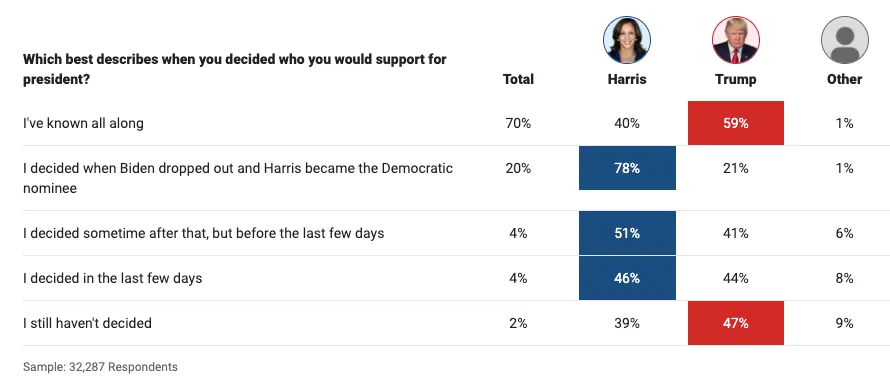[...]
We can’t know for sure how a Trump-Biden rematch would have turned out, since it never went the distance. But we can get a pretty clear picture, thanks to the massive VoteCast survey of the 2024 electorate. The survey’s findings, published in their most complete form by Fox News, make a strong case that Harris did better than Biden would have.
Let’s start with their respective favorability ratings. Biden’s score was abysmal: 40 percent of respondents viewed him favorably and 58 percent unfavorably. Harris’s rating was almost even: 47 percent favorable and 50 percent unfavorable. That’s a 15-point net advantage for her.
The survey also shows how people voted depending on their judgments of Biden’s presidency. Harris picked up 16 percent of voters who disapproved of Biden’s performance in office. By comparison, she lost only 7 percent of voters who approved of his performance. In the separate media exit poll, Harris did even better, picking up 16 percent of those who disapproved of Biden while losing only 3 percent of those who approved.
You could argue that these numbers don’t fully capture how Biden would have done. He, too, might have won a chunk of his disapprovers, since some of them also disliked Trump. And maybe if Biden had stayed in and showed more vitality in the campaign’s final months than he did in the debate, his favorable rating at the end would have been higher. Certainly, some Democrats who were wary of Biden would have “come home” to his camp as the election neared.
But one question in the VoteCast survey goes right to the heart of the Biden re-election fantasy. It asked people when they made up their minds and which candidate they voted for. Here are the results, as published by Fox News:

The top row of the table shows that 70 percent of voters knew all along which way they were going to vote. Of these, 59 percent voted for Trump and 40 percent for Harris. Since Harris didn’t replace Biden till July, it’s logical to infer that those 40 percent were going to vote for Biden. She basically inherited them.
Losing 70 percent of the electorate by a spread of 59 percent to 40 percent is very bad. It means that Biden put Harris in a serious hole. When you do the math, it means that she began her leg of the relay with locked-in support from only 28 percent of the electorate, compared to Trump’s 41 percent.
WHAT HAPPENED WHEN HARRIS TOOK OVER? The next row of the table answers that question. Twenty percent of voters made their decisions when Biden dropped out and Harris stepped in. They went for Harris over Trump by a ratio of nearly four to one.
That’s a big deal. Winning one-fifth of the electorate by 78 percent to 21 percent gets you a net gain of about 11 percent of the overall vote. If you think of the election as a layered sequence—the candidate starts with a base of loyalists and then adds supporters as they commit to her—the Biden-to-Harris handover was remarkably effective. Biden handed his vice president a 13-point baseline deficit, and she closed the gap to about 2 points.
The remaining rows of the table tell the rest of the story. Harris continued to outpoll Trump among people who made up their minds in the weeks that followed. Among people who decided at the end, she broke even. (The VoteCast poll began during early voting, so the bottom row shows people who hadn’t yet cast their ballots. Another version of the table shows that the late deciders—the 6 percent of voters in the bottom two rows—split evenly between Trump and Harris.)
That’s the ball game. Harris entered the campaign with a big baseline deficit and nearly closed that gap when she replaced Biden. But she couldn’t win over enough late deciders to catch Trump.
